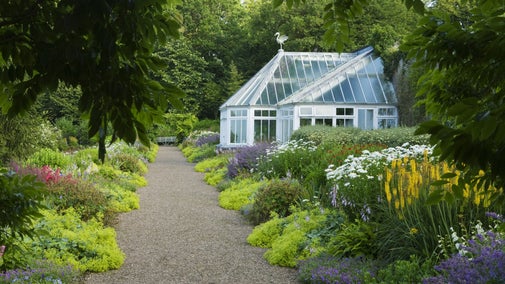
Arlington Court and the National Trust Carriage Museum's collections
Explore the objects and works of art we care for at Arlington Court and the National Trust Carriage Museum on the National Trust Collections website.

At the Carriage Museum at Arlington Court you can see over 40 vehicles, ranging from elegant coaches used for state occasions to humble carts that would have carried servants.
The Craven State Chariot was built for the Earl of Craven in the mid-19th century. In its original condition because it was used so rarely, it's now one of the most important carriages in the collection. This chariot was built by Hooper and Co., one of the very finest London coachbuilders in the 19th century.
State carriages were only owned by the nobility and would have been used for attending very important occasions such as the State Opening of Parliament, society weddings and grand receptions.
You can see the Craven crests on the carriage and, included in the silver-plated furniture on the outside, is the coats of arms of the Craven family on the hammer cloth. The interior is beautifully lined in a bright, very rich shade of damask.

This travelling chariot took Gibbs Crawford Antrobus all over Europe during his career as a diplomat at the beginning of the 19th century.
Travelling chariots would be well equipped for long journeys and could be used for travelling from town house to country residence, or for journeys as elaborate as the Grand Tour of Europe.
This carriage has its original imperials – light wooden cases covered in leather – on the roof. On long journeys it would have been pulled by pairs or teams of horses hired at inns along the way and ridden by post boys, who would then hack the horses back from the next post. The horses were changed every 10–12 miles. This vehicle could also be converted for town use.
This speedy two-wheeled carriage was the Ferrari of its day and even sports similar bright colours. Built in the late 19th century, it was most recently used for tandem driving, where two horses are being driven one in front of the other.
The tail board of the carriage can be hinged down to make space for two passengers facing backwards, in addition to the driver and another passenger facing forwards.

Children’s carriages such as this little cart were often pulled by a large dog, or sometimes a goat or other animal. They were often based on full-sized ones and sometimes looked like a miniature version of the family carriage.
A cart like this, along with a Newfoundland dog called Bouncer, was given to the future George V when he visited Newfoundland in 1901. It is even possible that it was this exact cart as Edward VIII gave several carriages from the Royal Mews to the Science Museum, who own this vehicle.
After the death of Prince Albert in 1861, many individuals followed the example set by Queen Victoria of an extensive funeral and strict mourning. Whole emporiums were dedicated to selling anything you might need for a fashionable funeral, from stationery to coffins, and of course, an impressive vehicle for a final send off.
The hearse on display at the Carriage Museum was built in around 1900 and owned by Partis Undertakers of Faversham, Kent, where it was used until the mid-20th century. The horses used for funerals were always black and often had black ostrich feather plumes on the headpieces of their bridles and on their pads.

Explore the objects and works of art we care for at Arlington Court and the National Trust Carriage Museum on the National Trust Collections website.
Explore the evolution of carriages and their changing fashions, from the one with the disreputable image to the one with a royal seal of approval.

The house at Arlington Court is the work of generations of the Chichester family. Discover how each heir left their mark on the building you see today.

From the ever-changing flowers of the formal Victorian Garden to picture-perfect pleasure grounds, the garden at Arlington Court is beautiful whatever the weather. Step into the hidden walled kitchen garden for variety through the seasons.
